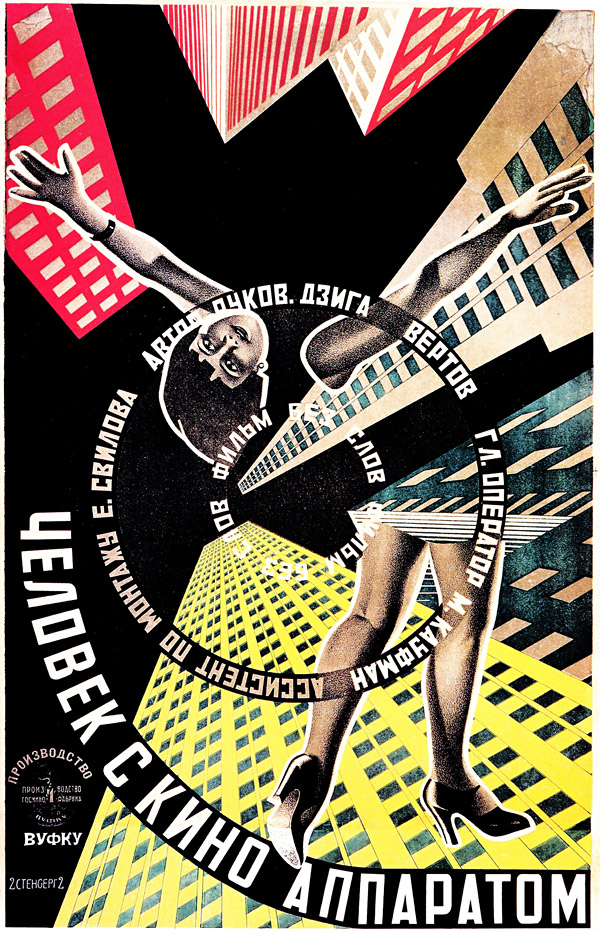
Dziga Vertov at the shooting of a film. A still from the documentary "The Gameless World".
SputnikDziga Vertov was the first to consider film not as a theatrical performance or a historical document but as an independent artifact. "I am the cinema eye. I am a mechanical eye. I am a machine showing you the world in the way only I can see it," he would declare in his early manifestos.
For Vertov the effectiveness of film's impression on the viewer is not related to the actors acting out an entertaining story in front of the camera, or to the camera being placed in some specific place, for example a meeting where Lenin was to speak. Its primary effect is caused by the interchanging of full shots, medium shots and close-ups, by the rhythm with which the shots alternate and how fast and slow motion are used.
Even official events whose filming he directed (between 1922 and 1925 he managed the department of newsreels at the All-Union Film Association, then State Cinema, which produced films in the USSR and engaged in censorship) were filmed from unexpected points and angles with a hidden camera: from a moving car, a factory pipe, the wheels of a train.
The plots of Vertov's earlier films have secondary meaning. His most famous and radical films, Cinema Eye (1924) and Man with a Movie Camera (1929), are large-scale film frescoes whose plots can be summed up with short phrases: "Life in a big city" and "The old and the new," while their artistry is generated by the parallelism of shots and the impetuous rhythm of the editing.
However, the first film received a medal and a diploma from the World Exhibition in Paris (1924) and the second was elected as one of the 10 best films of all time and the best documentary film by British film critics in 2012.
Of course, the development of the cinematographic language in the 1910-20s was developing in various countries, in both narrative and documentary films, and later in sound films. But Vertov indeed anticipated many of the works made by David Griffith, Fritz Lang and Leni Riefenstahl, whose Olympia (1938) is considered a model for documentary film.
However, like any avant-garde artist, though himself unaware of it, Vertov was very close to long-established traditions. The late articles of the great Russian writer Leo Tolstoy contain a categorical refusal of the conventions of traditional theater (Shakespeare's plays and classical opera), but also the idea that anticipated the concept of film editing: that art is born not with the description of vivid characters and their vicissitudes, but only with their "connection," that is, editing.
Vertov's real name was David Kaufman, which unambiguously points to his Jewish origin. But the desire of the talented youth from Bialystok (at the time part of the Russian Empire, today Poland) to change his surname upon arrival in Moscow was unlikely to have been due to anti-Semitism – in the 1920s it was not as developed as in the 1950s. Vertov, like many avant-garde artists, probably just chose a new name to herald "a new life."
In Ukrainian dziga means whirligig, spinning top, while vertov comes from the verb vertet (to spin). The two form something like "the spinning whirligig," a name that was entirely fitting for the man who bore it.
Dziga's brother Boris Kaufman, who was 10 years younger, emigrated from Russia after the revolution, graduated from the Sorbonne in Paris, moved to America and became a famous director of photography, working with Sydney Lumet and Elia Kazan. In fact, Kazan's On the Waterfront brought Boris an Oscar in 1953.
Fortunately, Vertov was spared the tragic fate of many avant-garde artists. He was not shot and was not sent to the camps. But after the Soviet government's brief affair with the avant-garde, Soviet leader Joseph Stalin began to favor "the imperial style" and Vertov's innovative work was no longer seen as useful.
During WWII Vertov shot three promotional films but all his other proposals were refused. From 1944 to his death in 1954 he worked as editor at the cinema magazine Novosti Dnya (“News of the Day”).
 Man with a Movie Camera poster. Source: DPA/Vostock-Photo
Man with a Movie Camera poster. Source: DPA/Vostock-Photo
Interest in Vertov was resuscitated towards the end of the 20th century when directors who signed the Dogma-95 (a conceptual manifesto of independent cinema in the 1990s whose chief ideologue was Lars von Trier) basically returned to the principles that Vertov had once declared: shooting in natural conditions, hand-held photography, and the use of a hidden camera and real characters.
In 1995 Michael Nyman created his original soundtrack to Man with a Movie Camera – defining proof, if any more were required, that avant-garde director Vertov had truly become a classic.
All rights reserved by Rossiyskaya Gazeta.
Subscribe
to our newsletter!
Get the week's best stories straight to your inbox